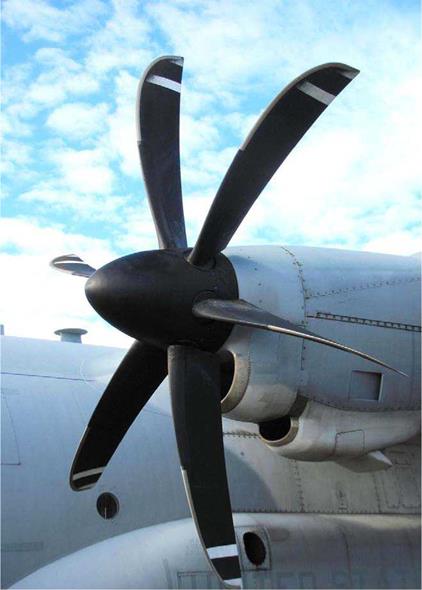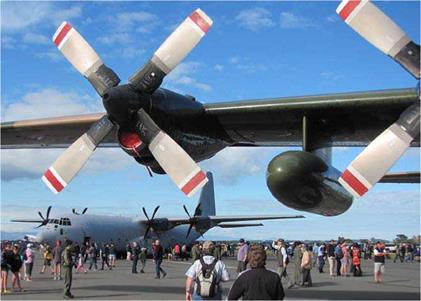Number of Blades
The solidity of the prop can be increased to absorb more power by increasing the number of blades mounted on the prop. However, there is a limit to the number of blades that can be used. Five-blades are the accepted maximum number for a metal prop and now, up to eight for a composite prop;
however, that is encroaching into the realm of Propfans. Six or more blades can be used on a composite prop due to their lower weight and superior efficiency over metal blades. The reason for the restriction on the number of blades is the air cascading over the following blades causing interference drag and reducing efficiency. A greater number of blades not only produce more thrust, but also more drag at the idle power settings which can be used to advantage by acting like an air brake. The cruise speed can be quickly reduced to approach speed combined with an increased rate of descent when desired.
|
BHP Diagram 14, Prop Diameter v. BHP |
Using three or more blades on a prop in place of a two – blade prop can be aesthetically pleasing, and hint at higher performance although this may not always be so. For example, the Cessna 207 light aircraft maybe equipped with either an 82 inch two-blade prop or the optional three-blade prop with a slightly smaller diameter. However, to quote from the Cessna 207 owner’s manual (POH), “There is no significant performance change with the three-blade propeller”. In contrast to this, when Piper Aircraft developed the Piper
Malibu, they found a two-blade prop gave the aircraft better performance in the cruise than that obtained from a three – blade prop. This may be attributed to prop blade loading; during low-speed operations such as take-off and climb, the three-blade prop has a lower prop loading. It can absorb more power and increase the static prop thrust, which in turn, will increase the initial acceleration during the take-off roll and improve the rate of climb. In effect, the three-blade prop does not have to work so hard. It is more efficient than a two-blade prop at lower speeds. At the higher speeds of cruise flight, the thrust available and hence the prop blade loading is lower still. This makes it more difficult for a three-blade prop to maintain a sufficiently high lift/drag ratio along with high efficiency. This may become evident with a slight loss in cruise speed, especially at higher altitudes. The aerodynamic drag can be
|
The Lockheed C-130J with six-blade scimitar props in the distance, is overshadowed by the older Lockheed C-130H with four-blade, square-tip propellers. |
expected to be less when the prop blade loading is low, which is usually found on three-blade props at cruise speed. On the other hand, a lightly loaded three-blade prop can produce as much drag as a two-blade prop. A two-blade prop with less solidity will suffer from too high prop blade loading and will be less efficient during take-off and climb. During cruise flight, the prop blade loading will be relatively higher than a three-blade propeller. This will enable the two-blade prop to produce a better lift/drag ratio and greater efficiency during cruise flight.
The number of blades also affects the vibration produced by the prop . It is a well-known fact amongst pilots that a prop with three or more blades runs smoother than a two-blade propeller. It was mentioned above; increasing the number of blades reduces prop blade loading and therefore less thrust per blade. This results in the vibration’s frequency being raised resulting in a reduction in the amplitude of vibration. When the prop produces higher vibration frequencies, the amount of vibration transmitted through the airframe to the occupants is less discernible and is felt as a smoother running engine.
There are many variables involved in determining a propeller’s efficiency. The aircraft designer must decide at what true air speed the two-blade prop becomes a better option than a three-blade prop. It was mentioned above; the three-blade prop produces better performance and efficiency during take-off and climb. Therefore, if the performance can be maintained right up through the normal cruise speed, then the three-blade prop is the right choice for that aircraft type. If the three-blade prop loses efficiency before the aircraft reaches its design cruise speed, then the designer is more likely to opt for a two-blade propeller. It all depends at what true air speed the three-blade prop becomes more efficient than a two – blade propeller mounted on that particular type of aircraft. Of course, the same argument applies when we compare a three-

|
blade propeller with a four-blade unit, or a four-blade prop with a five-blade prop, etc.
In conclusion, a three-blade propeller is better for take-off and climb performance with the added benefit of reduced noise and less vibration, but a two-blade prop may, or may not, produce better cruise performance. As with most things aeronautical, it is again a matter of compromise.













